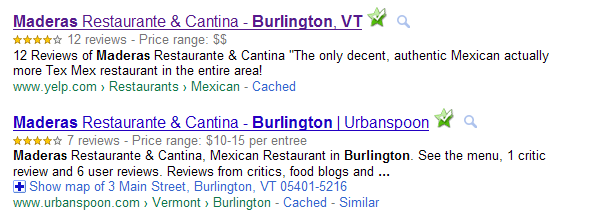Rich Snippet is a form of structured data that Google can use on its search results pages. It allows for a consistent, attractive display of information. The concept has been around since 2009, but has been slow to evolve perhaps because of foot-dragging on Google’s part, and perhaps because most developers seem unaware of, or unconcerned with it. Presently, it’s used on sites that feature reviews, people profiles, events, videos, product e-commerce and now recipes.
Let Me Introduce You
Below we can see rich snippets at work on Google’s SERP for “burlington vt maderas” (a Mexican restaurant across the street from us) on the Yelp and Urban Spoon listings.
I took a look at the source code on Yelp and found the following snippet that’s responsible for the 4 out of 5 star rating. [Second geek alert. Skip to familiar Google search result display.]
The number of stars and the number of reviews:
<div id=”bizRating”>
<div class=”rating”>
<span class=”star-img stars_4″><img class=”rating average” width=”83″ height=”325″ title=”4.0 star rating” alt=”4.0 star rating” src=”http://media1.px.yelpcdn.com/static/201012161267404880/i/ico/stars/stars_map.png”></span>
</div>
<span class=”review-count”<>span class=”count”<12>/span< reviews>/span<>a href=”#” id=”rating_graph”<Rating Details>/a>
</div>
The price range:
<span class=”pricerange”><a id=”price_tip” title=”Price range is the approximate cost per person for a meal including one drink, tax, and tip.<br><br>We’re going for averages here, folks.<br><br>$ = Cheap, Under $10<br>$$ = Moderate, $11 – $30<br>$$$ = Spendy, $31 – $60<br>$$$$ = Splurge, Above $61″>$$</a></span>
Rich Snippet can be good to know
“That’s nice, but my website doesn’t fall into any of the mentioned business categories.” Your website might not be able to take advantage of it yet, but if you provide a service or a product you will most likely be able to take advantage of this in the near future.
If your website is more information oriented, you may be better off creating a glossary of industry terms — in which case you don’t need to meet Rich Snippet. If you Google “define:Dividend Reinvestment” you will see a very limited list of websites that provide a definition, including our client, Clute Wealth Management. Definition searches are not as common as regular keyword searches, but they are still used and it is relatively easy to take advantage of them.
So, dear readers, how many of you know and like Rich Snippet? And how many could care less about Rich Snippet and his ilk?






Yep http://t.co/o6TAHJFK @aloganiq Adding rich snippets to content will significantly improve its ranking using categorized data. #vtweb2012